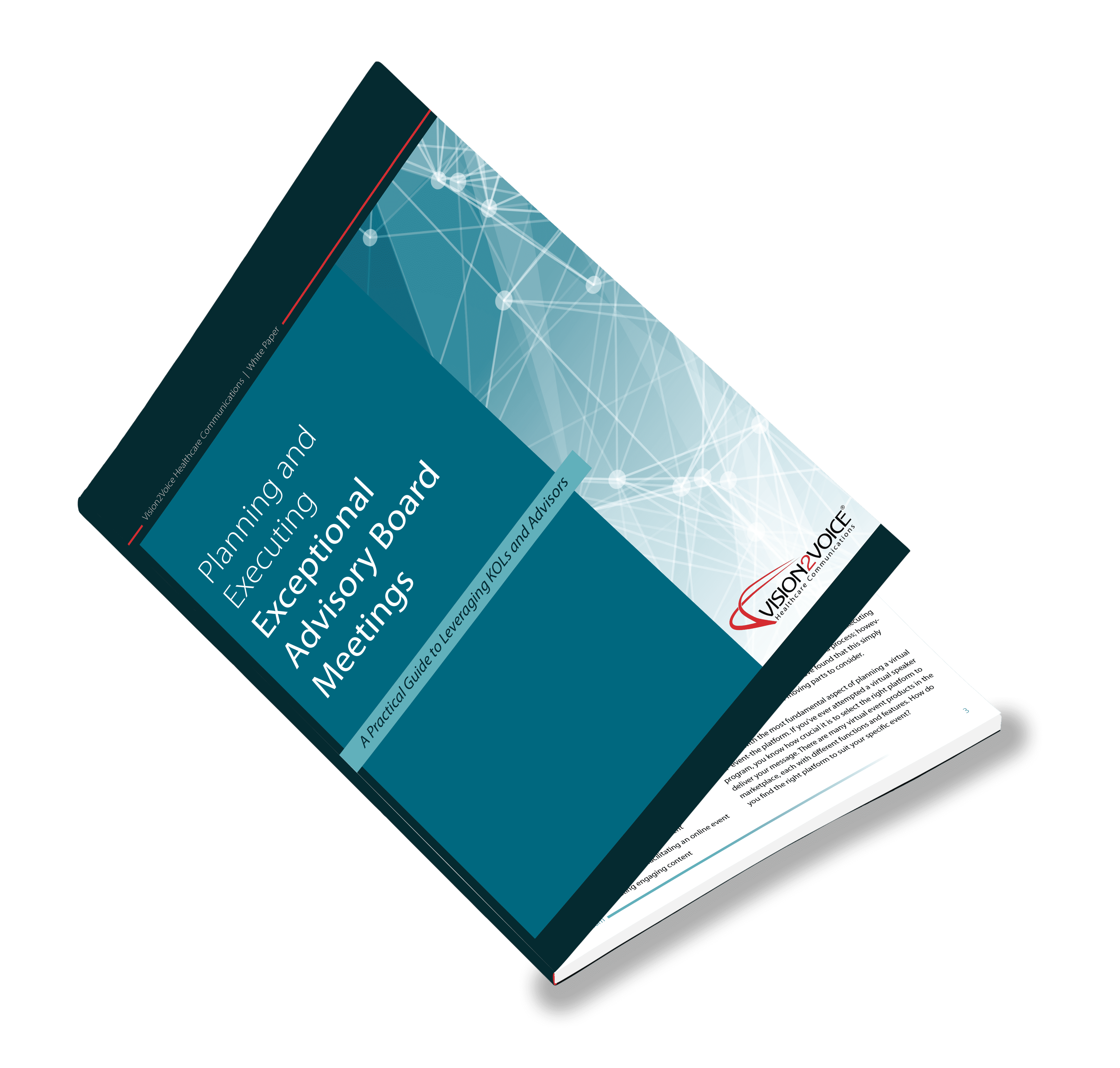
Advisory boards are a critical component to a successful pharma market–shaping strategy. They provide a window into the minds of top key opinion leaders (KOLs) to gain valuable insights on products, clinical studies, competition, or market dynamics. At the heart of a successful advisory board is a planning team that sets a program agenda designed to pull both pragmatic and emotional insights from the expert advisors. Planning for effective communication will allow for a higher-impact advisory board so you can glean more insights from participants. To foster engaging and meaningful dialogue within your advisory board, these 7 planning steps can make the difference between a good and a great advisory board:
1. Choose the right meeting format needed to achieve your goals.
Advisory board meetings can be conducted both virtually and in-person. How do you know which format is right for you? Ask yourself the following three questions:
- How much content is there to discuss? Virtual advisory boards are best conducted in 4 hours or less. While they can be effective, do not tend to be as in-depth.
- How important is it to build longer-term relationships with the advisors for key consulting initiatives? Relationships are always best built and nurtured in-person. However, sometimes you just need to get feedback from KOLs more quickly. When that is required, virtual advisory boards can efficiently serve this purpose.
- What kind of budget am I willing to allocate? There are several factors to consider, including whether your KOL advisors are located inside or outside major metro areas; their availability to travel; whether your budget can accommodate airfare, hotel, and food; and the amount of lead time you have to coordinate meeting logistics.
While in-person interaction is traditionally preferred, virtual advisory board meetings are growing in popularity thanks to advancements in digital platform technology that seamlessly enable successful online conversations. Read our case study on how Vision2Voice helped one pharmaceutical company pivot from an in-person to virtual advisory board.
2. Select the right advisory board chair.
A strong, well-respected chairperson can attract an influential audience including KOLs and advisors who are in high demand and may have competing priorities. Your chair should be available to help review and fine-tune your objectives, determine agenda topics, identify faculty speakers, and connect you to other attendees who can help you fill in content gaps. When choosing a chairperson, there are a number of criteria to evaluate, which you can find in our do’s and don’ts checklist here.

3. Schedule advance-planning discussions with your faculty.
Conduct web conferences with your faculty advisors who will be presenting at the meeting. This way you can see one another and the content at the same time. Explain to faculty presenters early on to get to the WHY of their subject matter and not just to the WHAT. This will ensure that each presentation is optimized to achieve the desired objectives and encourage active discussion between participants.
4. Make sure there’s ample time for dialogue.
As a rule of thumb, it’s best to allocate about 50% of the meeting time for a formal presentation, and 50% of the time for feedback from advisory board attendees. The goal is to gain as much feedback from participants as possible. Proper planning will help ensure that faculty presentations stay within reasonable time limits and don’t overtake the agenda.
5. Host a slide review session before the meeting.
Your advisory board chair should be present as each faculty advisor reviews their slides. Although planning discussions have occurred in advance, this is the time to provide final feedback, fine-tune content, stay on schedule, and ensure that presenters are asking the right questions to prompt input.

6. Create an open environment.
When organizing an onsite advisory board meeting, you’ll want to set the table for a discussion that puts everyone at the same hierarchy and encourages engagement. A U-shaped set-up is ideal. As a result, your company’s representatives can sit at the table to participate but try to avoid overrepresentation. Think in advance who really needs to be present and invite only those who would benefit first-hand from hearing feedback directly versus viewing a recording later. Too many colleagues from the host sponsor make advisors feel overwhelmed, which could inhibit discussion and compromise achieving your objectives.
7. Seize every opportunity to get to know your participants.
Building strong relationships with your advisors before, during, and following the meeting is important. This makes them more receptive to the content and more willing to share their honest perspective. Understanding their position helps draw the best quality input to guide your brand’s lifecycle and uncover the “why” behind the “what.”

Planning and Executing Exceptional Advisory Board Meetings
For more tips on how to leverage KOLs and advisors, download our white paper now!
Click Here to Download White Paper
Need help with your next advisory board meeting? We’d love to put our proven approach to work for you!
Stay tuned for more topics on how to identify, recruit, and leverage KOLs in upcoming issues of Vision2Voice’s INSIGHT newsletter.





